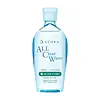Senka A.L.L. Clear Water Micellar + Toner Formula Acne Care Versus Acne-Aid Micellar Water Sensitive Skin
What's inside
What's inside
 Key Ingredients
Key Ingredients

 Benefits
Benefits

 Concerns
Concerns

No concerns
 Ingredients Side-by-side
Ingredients Side-by-side

Water
Skin ConditioningDipropylene Glycol
HumectantPPG-30-Buteth-30
Skin ConditioningGlycerin
HumectantSalicylic Acid
MaskingSodium Citrate
BufferingAminomethyl Propanol
BufferingPhenoxyethanol
PreservativeEthylhexylglycerin
Skin ConditioningPotassium Cocoyl Glutamate
Citric Acid
BufferingSodium Metaphosphate
BufferingButylene Glycol
HumectantSericin
Skin ConditioningTocopherol
AntioxidantPotassium Sorbate
PreservativeSodium Metabisulfite
AntioxidantSodium Acetylated Hyaluronate
HumectantSodium Hyaluronate
HumectantXanthan Gum
EmulsifyingChamomilla Recutita Flower Extract
MaskingWater, Dipropylene Glycol, PPG-30-Buteth-30, Glycerin, Salicylic Acid, Sodium Citrate, Aminomethyl Propanol, Phenoxyethanol, Ethylhexylglycerin, Potassium Cocoyl Glutamate, Citric Acid, Sodium Metaphosphate, Butylene Glycol, Sericin, Tocopherol, Potassium Sorbate, Sodium Metabisulfite, Sodium Acetylated Hyaluronate, Sodium Hyaluronate, Xanthan Gum, Chamomilla Recutita Flower Extract
Water
Skin ConditioningPEG/PPG-25/30 Copolymer
SolventHexylene Glycol
EmulsifyingGlycerin
HumectantSodium Benzoate
MaskingCetylpyridinium Chloride
AntimicrobialCetrimonium Chloride
AntimicrobialMenthyl Lactate
MaskingPEG-6 Caprylic/Capric Glycerides
EmulsifyingDisodium EDTA
Citric Acid
BufferingNiacinamide
SmoothingZinc PCA
HumectantBHT
AntioxidantAloe Barbadensis Leaf Juice
Skin ConditioningMaltodextrin
AbsorbentHydrolyzed Algin
Phenoxyethanol
PreservativePotassium Sorbate
PreservativeZinc Sulfate
AntimicrobialWater, PEG/PPG-25/30 Copolymer, Hexylene Glycol, Glycerin, Sodium Benzoate, Cetylpyridinium Chloride, Cetrimonium Chloride, Menthyl Lactate, PEG-6 Caprylic/Capric Glycerides, Disodium EDTA, Citric Acid, Niacinamide, Zinc PCA, BHT, Aloe Barbadensis Leaf Juice, Maltodextrin, Hydrolyzed Algin, Phenoxyethanol, Potassium Sorbate, Zinc Sulfate
Ingredients Explained
These ingredients are found in both products.
Ingredients higher up in an ingredient list are typically present in a larger amount.
Citric Acid is an alpha hydroxy acid (AHA) naturally found in citrus fruits like oranges, lemons, and limes.
Like other AHAs, citric acid can exfoliate skin by breaking down the bonds that hold dead skin cells together. This helps reveal smoother and brighter skin underneath.
However, this exfoliating effect only happens at high concentrations (20%) which can be hard to find in cosmetic products.
Due to this, citric acid is usually included in small amounts as a pH adjuster. This helps keep products slightly more acidic and compatible with skin's natural pH.
In skincare formulas, citric acid can:
While it can provide some skin benefits, research shows lactic acid and glycolic acid are generally more effective and less irritating exfoliants.
Most citric acid used in skincare today is made by fermenting sugars (usually from molasses). This synthetic version is identical to the natural citrus form but easier to stabilize and use in formulations.
Read more about some other popular AHA's here:
Learn more about Citric AcidGlycerin is already naturally found in your skin. It helps moisturize and protect your skin.
A study from 2016 found glycerin to be more effective as a humectant than AHAs and hyaluronic acid.
As a humectant, it helps the skin stay hydrated by pulling moisture to your skin. The low molecular weight of glycerin allows it to pull moisture into the deeper layers of your skin.
Hydrated skin improves your skin barrier; Your skin barrier helps protect against irritants and bacteria.
Glycerin has also been found to have antimicrobial and antiviral properties. Due to these properties, glycerin is often used in wound and burn treatments.
In cosmetics, glycerin is usually derived from plants such as soybean or palm. However, it can also be sourced from animals, such as tallow or animal fat.
This ingredient is organic, colorless, odorless, and non-toxic.
Glycerin is the name for this ingredient in American English. British English uses Glycerol/Glycerine.
Learn more about GlycerinPhenoxyethanol is a preservative that has germicide, antimicrobial, and aromatic properties. Studies show that phenoxyethanol can prevent microbial growth. By itself, it has a scent that is similar to that of a rose.
It's often used in formulations along with Caprylyl Glycol to preserve the shelf life of products.
Potassium Sorbate is a preservative used to prevent yeast and mold in products. It is commonly found in both cosmetic and food products.
This ingredient comes from potassium salt derived from sorbic acid. Sorbic acid is a natural antibiotic and effective against fungus.
Both potassium sorbate and sorbic acid can be found in baked goods, cheeses, dried meats, dried fruit, ice cream, pickles, wine, yogurt, and more.
You'll often find this ingredient used with other preservatives.
Learn more about Potassium SorbateWater. It's the most common cosmetic ingredient of all. You'll usually see it at the top of ingredient lists, meaning that it makes up the largest part of the product.
So why is it so popular? Water most often acts as a solvent - this means that it helps dissolve other ingredients into the formulation.
You'll also recognize water as that liquid we all need to stay alive. If you see this, drink a glass of water. Stay hydrated!
Learn more about Water